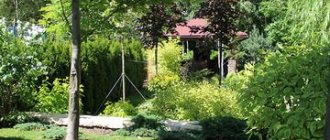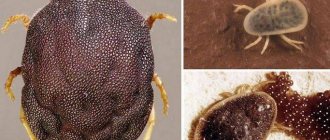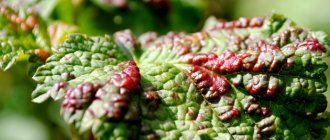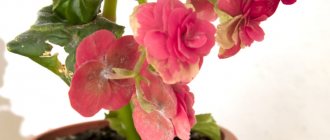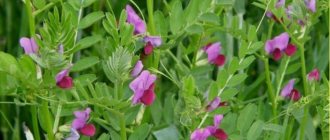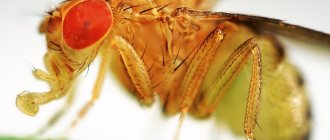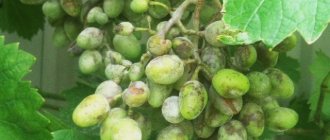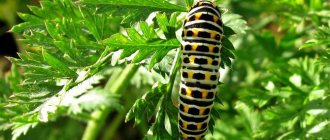Category: Plant protection Reading time: 11 min · Views: 194
Currants are valued for their tasty and healthy berries, but they have many pests that can cause disease and death of the bushes. To reap a decent harvest, you need to take care to protect the bushes from diseases and harmful insects. If measures are not taken in time, the entire garden will be in the attention zone of pests, because insects multiply very quickly. In the article we will look at what pests of currants there are. Methods of chemical and non-chemical protection against insects in the garden.
Pests that attack black, white and red currant bushes (worms, bugs, larvae)
There are several dozen harmful insects that infect currant bushes. They differ in habitat, appearance and lifestyle. This determines not only the speed of spread and symptoms, but also the features of combating them. For treatment to be effective, it is important to be able to determine the type of pest based on typical signs.
Glassware
The peak of distribution occurs 1-2 weeks after the start of flowering.
It most often affects blackcurrant and gooseberry bushes. In warm regions, the glass is activated before the berries ripen. This is a small butterfly that looks like a wasp. It has an elongated body with black and yellow stripes. Females lay from 40 to 60 eggs in buds 2-4 years old, in cracks in the bark. After 10-15 days, green worms appear and can eat the plant tissue. Pupation of the worms occurs the following spring, in May.
In the first year, it is difficult to notice the pest, since there are no external symptoms of infection. The yield is slightly reduced, the berries are formed later. Active inhibition of currant development is observed in the second year, from the beginning of spring. Flowers do not develop on damaged branches and they dry out. When cut, you can see clear passages with insect excrement. Read about varieties for the Moscow region that are resistant to bud mites in this article.
Some gardeners call the glass beetle a bud mite. However, the pest has nothing to do with this type of arthropod.
Spider mite
They are especially noticeable on leaves and shoots; in appearance they resemble a yellow spider.
Activated by high humidity and sudden temperature changes. The presence of a mite on a plant can be determined by the appearance of a characteristic web on all vegetative parts.
The pest feeds on plant sap. This leads to disruption of the development and metabolic processes of the plant. The leaf blades curl and the bush begins to slowly wither. Productivity decreases, currants become weakened and often cannot survive the winter. The chances of contracting powdery mildew and other fungal diseases increase. Read how to get rid of powdery mildew on currants here.
Aphid
Pests multiply quickly and live in large colonies.
The small parasitic insect has a body length of up to 2.2 mm. Depending on saturation, aphids have a transparent, yellow or green color. The pest feeds on plant sap, which leads to inhibition of the development of the bush, a decrease in its productivity and death in the later stages.
It is not difficult to identify aphids on currants - there are a huge number of pests on the plant. Characteristic swollen spots of a red or yellow hue appear on the leaves. Death is usually observed in winter, as the bush's immunity decreases. In addition, aphids are carriers of a large number of viral infections.
The presence of ants in the garden is one of the signs of the presence of aphids. These insects live in symbiosis, which leads to severe damage to shrubs.
leaf roller
Damage to the plant is caused by caterpillars that feed on its sap and eat the leaves.
A multi-species butterfly species distributed throughout the world. Outwardly it resembles a moth, the wingspan does not exceed 25 mm. They are painted gray-brown with streaks along the edges. Adults have a short lifespan but lay many eggs.
The insect is dangerous when it is infested en masse, which leads to complete drying of the bush. The pest can be identified by the condition of the leaf blades - they begin to curl up and dry out. Currant yields decrease and death occurs in the second year before flowering begins.
Ants
These insects most often appear on plants infected with aphids.
These are small insects characterized by developed intelligence. They live in colonies of high numbers.
They dig many tunnels in the ground and build nests in the tree trunk area. If there is mechanical damage to the trunk, they can also settle in the wood.
Ants are dangerous not only in themselves, but also as carriers of aphids. Since they settle in the ground, the main impact falls on the root system. As a result, the plant grows slowly and stops bearing fruit. Death can occur over several years.
It is not easy to get rid of ants due to the large size of the herd.
Shchitovka
The striped bug causes leaves to curl, fall off and become necrotic.
Externally, these are small bugs up to 4 mm long, resembling brown spots. They have a dense shell that covers the entire body. They live on the underside of leaves, young shoots and petioles. Females lay 200 to 500 eggs in early spring, which feed on plant sap. In one season, an adult can leave 2-3 offspring; in winter, the larvae develop under the scutes.
Infestation can be determined by the appearance of the bush. The ovaries begin to dry out and crumble. If treatment is not started in time, the plants die within 1-2 years.
The scale insect's shell protects it from external conditions, as well as from the effects of insecticides. Complex treatment with chemicals in several stages is required.
Ognevka
The wings of the insect are painted in a grayish tint with a silver coating.
A common pest that affects gooseberry and currant bushes in the middle and northern zone. Externally, the insect is represented by a butterfly with a wingspan of up to 3 cm.
Their green larvae pose a danger to planting. They feed on the tissues and sap of the plant, eating the leaves. A white coating appears on the berries, which intensifies during the formation of pupae. The plant slowly dries out, the berries become small and deformed.
When choosing a control method, you should decide on the type of pest, since the infection of the moth is similar to the appearance of spider mites and bud moths.
Caterpillars that can eat currant bushes in the garden - bud moth, gall midge and others
This is a large group of pests that are larvae of adults. They are dangerous to the plant, feeding on its sap and tissues. Caterpillars have an inordinate appetite and are capable of destroying an adult bush in one year. The following insects leave larvae on currants:
- bud moth;
- gooseberry moth;
- gall aphids on red and black currants;
- leaf roller;
- sawfly;
- glassware;
- moth.
Caterpillars can be detected when the first signs of suppressed growth and development of the bush appear. As a rule, these are curled and yellowed leaves and deformed shoots.
Moth caterpillars
The currant moth has the shape of a small butterfly with a yellow head and long narrow wings. It is distinguished by the presence of pale yellow spots on the wings. The moth lays eggs in berry ovaries, which turn into caterpillars on currants and cause significant harm to the bush.
At the initial stage of development, the caterpillars are red in color, then they acquire a light green color, and closer to the final phase of development they become gray-green.
The buds of the plant are affected, which then dry out. Black, white and red currants are susceptible to moths and their caterpillars. Moreover, pests infect about half of the buds, which significantly reduces the yield.
To combat it, it is necessary to spray the currants with fufanon, kemifos or actellik. Spraying should be done in the spring before buds open.
Why do the leaves curl?
Curling of leaf blades is one of the noticeable signs of pest activity on currants. This is typical for damage by caterpillars and occurs in the later stages, when the vegetative parts begin to die off. In addition to insects, leaf deformation occurs due to a deficiency of nitrogen and potassium in the soil or due to insufficient moisture. A similar symptom occurs when infected with fungal, bacterial and viral infections. All unhealthy leaf blades must be removed as they appear. This slows down the rate of death of the bush and reduces the number of pests.
Leaves provide photosynthesis. When they twist, the natural nutritional processes of the plant are disrupted, which leads to inhibition of development and death.
Black caterpillar
The armyworm is a small nocturnal butterfly with brown, jagged wings. It produces black caterpillars, the length of which can reach 4 cm. The pest lays eggs in the buds and leaves. Caterpillars destroy leaves, almost always completely.
Such caterpillars are found on red currants, black currants, white currants, and most other bush plants. It also attacks deciduous trees. You need to fight the Owl in the same way as the hairy moth.
Ways to combat diseases and pests
Dealing with insect infestations and diseases is a complex process. It includes not only active control measures, but also preventive measures. It is important to carry out all procedures within a specific time frame, which makes it possible to prevent and combat the appearance of pests in the garden as much as possible, and reduce the harmful effects of chemicals on the crop.
How to fight in early spring
After the snow melts, it is necessary to trim off all old and deformed parts of the plant. Formation is carried out before the buds begin to swell, when the bush is still in the dormant stage. In addition, the first treatment with fungicides and insecticides is carried out to prevent infection by early pests. It is better to use broad-spectrum drugs, since they affect not only adults, but also their larvae.
Some gardeners can simultaneously pour boiling water over the tree trunk area to kill insects that have not yet left their winter quarters. The recommended period of operation is the end of March or the beginning of April, depending on the climate in the region.
How can you water currants in the summer?
This stage of work should be approached carefully - when using powerful agents, metabolic processes can be disrupted and plant growth can be inhibited. It is recommended to use traditional methods (potassium permanganate solution, onion peel decoction and others), as well as biological fungicides. This avoids deterioration in the taste and quality of the berries. Spraying of the planting is carried out every 2 weeks; during treatment, attention should be paid not only to the foliage and shoots, but also to the area near the trunk. Throughout the summer, it is important to feed currants to strengthen vitality and immunity.
How to spray berries during ripening and fruiting
At this stage, only folk remedies are used, since chemicals affect the yield. For processing, use onion decoction, soap solution or dusting with wood ash. Also read about laundry soap as a remedy for aphids at this link. Among insecticides, biological agents are preferred - they are not toxic, but demonstrate high efficiency. During the fruiting period, it is recommended to spray the bush with copper-containing fungicides (vitriol solution, Bordeaux mixture) or a suspension of colloidal sulfur.
The last treatment for planting currants is carried out after harvesting and most of the foliage has fallen. This allows you to destroy pests that settle on the plant for the winter.
Preparations that can destroy pests and get rid of bugs and worms
The market offers a wide range of products for controlling pests on currants. Among them there are both chemical agents and biological solutions to enhance the vital activity of beneficial bacteria. The choice of a specific substance depends on the type of insect, the stage of vegetation and the period of treatment.
Chemicals that can save a plant
They are very effective, but can be toxic to the plant. Depending on the composition, they are divided into specialized products and broad-spectrum drugs. They inhibit the vital activity of the insect, leading to its death from physiological disorders. Popular brands of insecticides:
- Aktara . Affects all types of insects. It has moderate toxicity and demonstrates effectiveness against scale insects, aphids and whiteflies. Belongs to the group of neonicotinoids and has a wide spectrum of action.
- Aktellik . The drug has intestinal contact action. Effective against insects that chew leaves. Recommended for processing in early spring. Has high toxicity.
- Apollo . Contact acaricide aimed at destroying herbivorous mites. Affects larvae and green eggs. Adults become sterile after treatment. Safe for humans and bees.
- Confidor . Systemic insecticide with contact-intestinal action. Used to control gnawing pests. Suitable for processing soil and bushes.
When working with chemicals, you should follow safety precautions - wear personal protective equipment, wash your hands thoroughly after the procedure. Spraying is carried out in two stages with an interval of 8-14 days.
Biological preparations for the destruction of insects - beetles, worms, yellow spiders, etc.
A large group of drugs that are mildly toxic to plants. They are of biological origin, often made from bacteria. They form beneficial microflora in the soil, which leads to increased immunity of the bush and the destruction of insects. The most famous of them:
- Fitoverm . Has an intestinal contact effect. Used to combat mites, thrips and leaf-eating caterpillars. Non-phytotoxic, suitable for processing in summer.
- Agravertine . Has a wide spectrum of action. Effective against ticks, beetles and larvae. The drug has a contact-intestinal action, suitable for spraying bushes and soil.
- Aktofit . The main substance of the composition is aversectin. Used to protect currants from a large number of pests. Active against aphids, mites and beetles, as well as their larvae.
When processing plantings, it is important to follow the dosage specified by the manufacturer and the spraying schedule. To achieve a lasting effect, the work is carried out at least twice.
Preparations of biological origin are acceptable for use during the period of fruiting and flowering. They have slight toxicity to the plant and do not affect the taste and composition of the berries.
Currant bud mite
A very dangerous pest due to its small size. Lives and feeds in currant buds. The affected buds swell and resemble a small head of cabbage.
Currants are treated against bud mites in the spring. Such products are used as Fufanon, Actellik, Akarin, Kemifos and Fitoverm.
It is important to spray the bushes in time, since about 3,000 mites can overwinter in one bud, which then quickly infect healthy buds. But, the affected kidneys must be removed. The bushes need to be sprayed before flowering, at the moment the buds open.
Currant leaves curl, what to treat - what to do first and finding the cause of the problem (115 photos)Spider mites on cucumbers: methods of fighting and getting rid of them using folk methods. 115 photos and videos of growing cucumbers
Why tomato leaves turn purple: subtleties of growing seedlings and tips for planting tomatoes with your own hands
Folk remedies using iodine, vinegar and soap solution
A large group of methods that are moderately effective and safe for plants and soil. Treatment can be carried out at any stage of the growing season. Popular folk remedies:
- Infusion of tobacco . Prepared at the rate of 400 g of dry leaves per 10 liters of water. Used for processing currants in spring and summer. Effective for prevention, but has a weak effect on ticks.
- Garlic infusion . Suitable for processing bushes and soil. Useful for controlling mites and aphids. To prepare, you need to mix 400 g of garlic per 10 liters of water, let it brew for 24 hours.
- Vinegar . Recommended for soil treatment in spring. Destroys larvae and pests overwintering in the soil. The working solution is diluted with water to avoid burns to the roots.
- Iodine solution . Useful against most currant pests, and also improves soil fertility. You can spray the solution at any stage of bush development; it often acts as an additional component for a soap solution or onion peel infusion.
Several dozen folk remedies are known. To prepare them, I use infusions of herbs and vegetables, laundry soap and available pharmaceutical preparations - iodine, potassium permanganate and hydrogen peroxide. It is advisable to combine the treatment with chemicals. Read about ammonia for aphids on currants in this material.
Description of currant varieties for the Moscow region that are resistant to pests
During breeding, special attention is paid to currant resistance to infection by diseases and pests. The most resistant varieties for the Moscow region:
- Black : Curiosity, Venus, Mermaid, Perun.
- Red : Early sweet, Viksne, Natalie.
- White : Smolyaninovskaya, Dessert, Primus.
The plant’s natural immunity is not able to completely protect the plant from infection. However, when choosing resistant crops and competently carrying out preventive work, the risk of harmful insects and diseases is reduced to a minimum.
Bottom line
Not only people love to eat currant berries; this shrub attracts many different parasites and pests. If you do not take care of the safety of the branches and buds of the plant, they will be instantly destroyed by insects. Pests are also carriers of various diseases - late blight and late blight.
How to deal with currant pests? If the bush is heavily infested with parasites, the branches should be immediately cut off at the root and burned in a fire. But it is better not to allow the plant to become completely damaged and to use preventive spraying.
Shrubs can be treated with chemical and herbal solutions; ash infusion and a solution of laundry soap help well. In order to repel pests from fruit bushes, onions/garlic or nectar-bearing plants are planted next to them to attract aphid-loving insects.
A competent approach to protecting berry bushes from parasites will help preserve the harvest.
What to plant next to currants to prevent pests
Some plants secrete phytoncides and essential oils that repel pests. They are recommended to be planted next to currants as a preventative measure to protect the plant. The following types are suitable for this purpose:
- sage;
- thyme;
- onion and garlic;
- fennel;
- mustard;
- tansy;
- nasturtium;
- calendula.
In addition, planting ornamental or cultural plants allows you to decorate the garden and create a beautiful landscape composition. Considering how mustard grows next to currants, you need to plant annuals or biennial types of flowers.
conclusions
- Currants can be affected by a large number of pests. The provoking factor of this process is climate change, non-compliance with agricultural technology and care.
- Glassweed, mites, aphids, scale insects and moths are the most dangerous and common pests for the gooseberry family.
- Herbivorous insects lead to inhibition of plant growth, reduced yield and death within 1-2 years.
- To combat, chemicals, biological agents and traditional methods are used.
- For prevention, it is important to properly care for currants. The garden should be regularly treated with insecticides, pruned and resistant varieties should be selected.
Garlic tincture
Garlic is used against kidney and spider mites, aphids, whiteflies and some herbivorous caterpillars.
The infusion is prepared from 0.4 kg of chopped garlic and a bucket of water. After thorough stirring, cover the container and put it in a dark corner. After 5-6 hours, 1 liter of infusion is added to a bucket of water and the bushes are sprayed.
Another way to make an infusion to protect blackcurrants from pests: chop 200 g of the spicy vegetable and dilute with boiling water (4 l). Leave for 1 week. Add a quarter of a glass of this infusion to a bucket.

